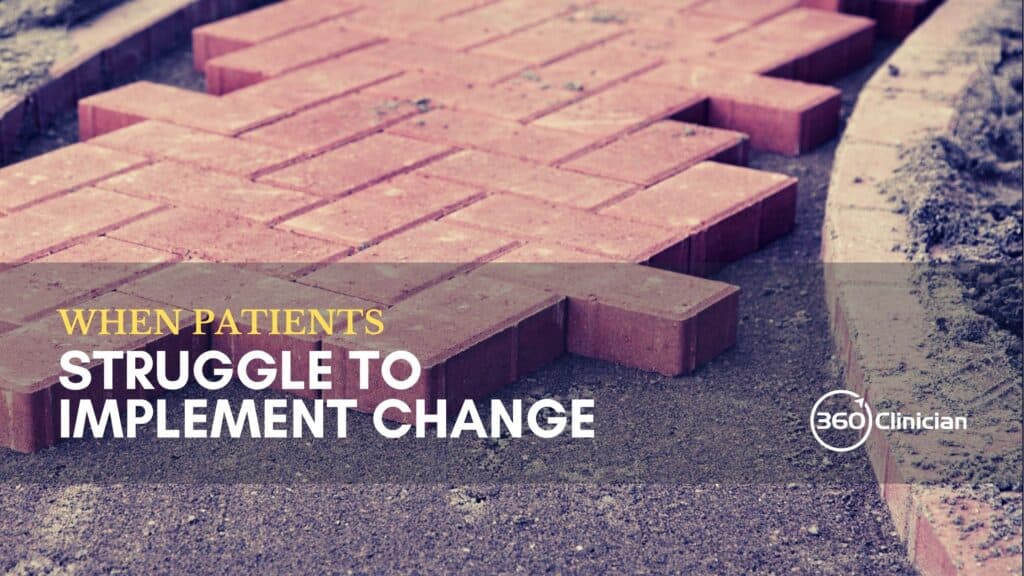Do you struggle with trying to motivate your patients to do their exercises?
Many physiotherapists have a difficult time motivating their patients to do their exercises. This can create an exhausting cycle for the therapist when they realize that despite their best efforts, the patient never does the exercises.
We’re convinced that motivation is the problem. But how often do we pause and ask ourselves is it a motivation problem in the first place?
Before I dive into answering this question, let’s talk about one of two traps we can fall into as physiotherapists.
We can fall into one of two traps.
We can blame ourselves as therapists. We think that we’re not doing enough.
Maybe we worry that we haven’t demonstrated the exercise properly.
Maybe we didn’t give enough rationale as to why the exercise is important.
There can be a number of reasons why we have failed our patient.
Or we can blame the patient.
We think they’re not trying hard enough. Maybe we think that the patient is lazy or unmotivated or that they don’t care about getting better.
But wait…that can’t be it as we know they’re coming to see us to get better.
We then maybe go back to the belief that maybe it’s something we’re doing wrong.
Sadly this can create a vicious cycle in our head.
Regardless of where we place the blame, the end result is the same. Our patient is not seeing the success you know they can experience because they’re not doing the exercises consistently.
Is a Lack of Motivation Really the Problem?
More often than not, when we feel stumped when our patients aren’t doing their home exercises, we come to the conclusion that it’s a patient motivation.
But is it really a motivation problem?
They’re likely in pain.
They’re coming to see you to get better.
They’ve likely paid money and/or taken time out of their busy schedule to see you.
They have activities to get back to doing the activities in life that they love.
All of these reasons (and likely many more) are good indicators of high intrinsic motivation.
So if it’s not a motivation then what is it?
It’s Time to Create a Bridge
It’s time for a change in perspective and strategy.
We can’t keep blaming the patient or looking at it as their fault. Nor can we put all of the burden on ourselves as therapists.
If we want better clinical results with our patients, we need to shift the blame away from a lack of motivation and instead reframe poor exercise adherence.
A useful analogy is one of a bridge.
We as therapists are tasked with helping our patients get to the island. This place where they can move and function with greater ease and enjoyment. The problem is they don’t know how to get there.
That’s why they’ve come to see us. We can talk about the importance of the bridge. We can give descriptions of the bridge and the key elements of the bridge. We can educate them on the importance of the bridge and things they’ll be able to do on the island.
But the patient is still stuck. They’re not sure how to build the bridge to get across the island.
We as therapists need to provide the tools, materials and knowledge for our patients in order to get them across the bridge.
In other words we have a responsibility to help build the bridges that will allow them access into activities of daily living with greater ease.
Remember, it’s not a motivation problem for our patients. They want to get to the island. We know that exercise is going to be the key way to get to their destination. But the challenge is that if our patients aren’t skilled in doing their exercises consistently the bridge will never get built and they’ll very likely never reach the island.
So How Do I Help Build the Bridge for My Patients
The first step is we need to stop the blame game – either towards ourselves or our patients. We can’t just blame them for not being motivated, and we can’t keep blaming ourselves either.
After that the next step is to identify one or two key exercises for our patients and help equip them to build consistency with those exercises.
The goal is to help our patients build the habit of exercise consistency.
To better flow,
Andrew
If you enjoyed this article and want to stay up-to-date on my newest content, sign up for the Clinical Flow Newsletter! There you will have access to special offers, exclusive content, and be part of a growing community of clinicians with the purpose of improving yourself and your clinical practice.


